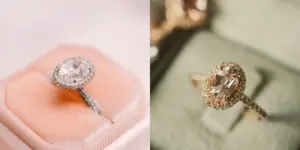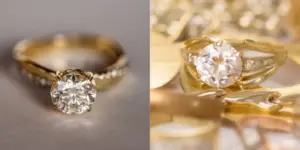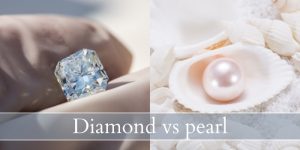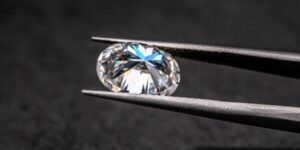if you’re in love with gems that change color or display several at a time then you’ve likely stumbled upon mystic topaz and alexandrite. Both gems are renowned for their color-change properties but they do this very differently.
So today we’re comparing alexandrite to mystic topaz, and taking a look at the many differences between them. This way you can make an informed decision when it’s time to get one for yourself, or for your loved one.
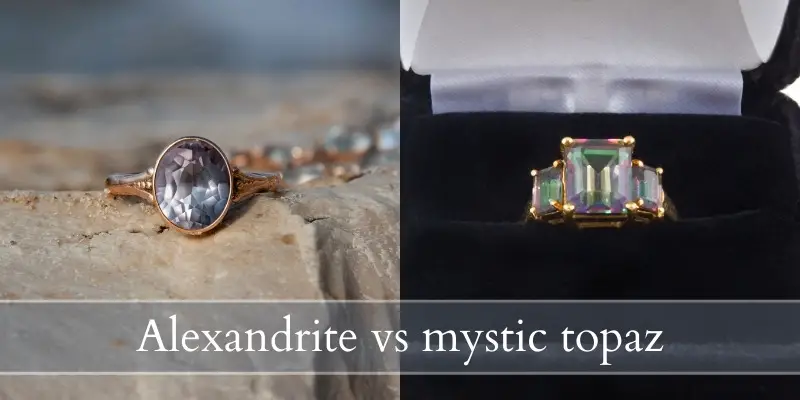
Alexandrite vs mystic topaz
Alexandrite is a natural gemstone with a natural color-change, while mystic topaz is a natural gem that has been coated with titanium to simulate a color change. Where alexandrite shifts in color depending on the light (outdoor, indoor) mystic topaz reveals the same colors under any light. There is a significant difference in the colors each gemstone shows, with alexandrite going form bluish-green to golden to reddish gold as the light changes, while mystic topaz shows varying flashes of green, pink, magenta, indigo, and yellow, all in different combination as the viewing angle changes.
Both gems are very different from one another and alexandrite is far more expensive than mystic topaz, retailing for as much as a prefect color untreated, natural ruby, while mystic topaz does not normally exceed $500 per carat.
All in all these gems are great with colors and are sure to offer a mesmerizing effect, but in different ways. Now let’s see what each of these gems really is, before we compare them thoroughly.
What is alexandrite ?
Alexandrite is an aluminate of beryllium, but not related to the beryl family (emeralds, aquamarine, heliodor). This gem is able to absorb different wavelengths of light, thus producing a color-change effect, depending on the light that enters it. Very fine quality alexandrite ranges from bluish-green to red with a hint of blue, but with a green middle ground. The green fade is never present in synthetic alexandrite.
What is mystic topaz ?
Mystic topaz is colorless topaz (silicate) that has been treated to reflect various colors, all at once. The treatment is not permanent and can be scratched off. This is a more recent type of topaz, and is not recognized as a valid type of topaz as it does not occur naturally.
Let’s compare the two gems to see their many differences and discuss them in detail. When you’re buying jewelry you don’t really want to be duped, and having information before-hand is crucial.
Read also: Citrine VS Yellow Topaz
1. Alexandrite changes colors naturally, mystic topaz is treated
The key factor that draws people to alexandrite and mystic topaz is their ability to showcase many colors. But each gems does this very differently. Here’s what we mean.
Alexandrite resemble both emerald and ruby. This is because in daylight it’s a bluish green, very similar to an emerald. Take the same gem inside, where there is incandescent light, and it will appear reddish, much like a ruby. If you were to keep the gem in neutral light, or at a window, with full daylight outside and all the light on in the house, you’d notice it’s both red and teal at the same time !
This is because of alexandrite’s peculiar chemical makeup, and it manages to reflect both ends of the light spectrum, depending on what light you give it. Low quality alexandrite, or rather alexandrite that is not the finest quality will only swing between yellowish green and brownish red. No blues included and the color tends to look a little muddy.
Mystic topaz changes its color due to vapor deposition of titanium. The base is a completely colorless topaz (common), so the light will still travel through the gem and reflect back outside, leading to various colors. A lot of green, purple, pink, and yellow are seem in mystic topaz.
2. Mystic topaz is more affordable than alexandrite
Because colorless topaz is common you will find that mystic topaz is quite cheap and easy to find. This means that any jewelry made with this gem will be affordable and easy to replace if the need ever arises.
Meanwhile natural alexandrite is amazingly expensive, about as expensive as natural, untreated rubies and just as rare. You see, alexandrite is not a common gemstone and what you will often find on the market is synthetic alexandrite. That version is also cheap, so it will retail for about as much as mystic topaz (around $20-500 per carat).
3. Alexandrite is a bit harder than mystic topaz
There is a slight difference in hardness between these two gems, and since mystic topaz has its color treatment on the outside this matters a lot.
Alexandrite ranks at 8.5 on the Mohs scale of hardness. For context, a diamond is a 10 and pearls are an average of 3 on the same scale. Topaz is an 9 on the Mohs scale, which is still a fairly hard stone but that 0.5 difference can mean a lot when it comes to scratching and chipping.
4. Mystic topaz reflects a rainbow, alexandrite has a set range
When it comes to the way each stone looks as the light hits it, mystic topaz has a very wide range of colors to display. Each time you turn the gem, some colors appear, some disappear, and it’s always a new part of the gem that flashes a new color. So you can get flashes of varying degrees pf pink, magenta, green, indigo, yellow, and golden-yellow form the entire gem, in different combinations.
Alexandrite on the other hand has a set range of colors that it will reflect, and they are entirely dependent on the type of light the gem is in. Fine natural alexandrite will go from bluish-green to green to reddish hues when transferred from outdoor light to indoor. The green is never missing in real alexandrite. Synthetic alexandrite will simply change from teal to raspberry, no green.
There is also a significant color saturation variation in alexandrite. While all mystic topaz offers impressive color flashes, not all alexandrite gems offer such an impressive change. Some are slight, some are pale, and most of the time real alexandrite is fairly small (1 ct at best).

I’m the main author for jewelrymaterialguide.com. I started this site after we did tons of research before our wedding and noticed that there is information about rings, jewelry, and so on that is really hard to find on the internet.

